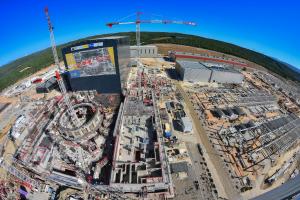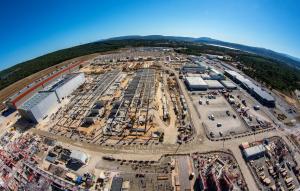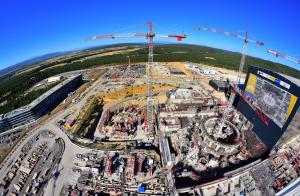Summer postcards from the ITER worksite
17 Jul 2017
-
ITER Communications
The latest harvest of ITER construction photos may be taken from the same point—the tallest crane on site—but there is always an abundance of new detail to be gleaned.
Little free space remains on the 42 hectares (100 acres) of the ITER scientific platform. Sandwiched between the cooling tower zone and concrete batching plant at the northern end (far left) and the electrical switchyard to the south (far right) are the work areas for the Tokamak Complex (centre crane), the cryoplant (middle right, all grey) and the buildings for magnet power conversion (twin structures, right). Any free space is used for storage. At the top of the image, manufacturing is underway in on-site facilities for the cryostat and one of the magnet systems, the poloidal field coils.
A year ago, the Assembly Building had just been insulated with several layers of cladding and equipped with overhead handling cranes; work on the circular bioshield was newly underway; the cryoplant was still at foundation level; and a large stretch of land now occupied by the twin Magnet Power Conversion buildings was but a barren steppe.
A large covered parking area has been added to the contractor zone at right, where other temporary buildings house contractor teams, workshops and user facilities such as the canteen and infirmary. Currently, there are 1,900 workers participating in ITER construction in two daily shifts.
Today, in the seventh year of ITER building construction, the platform seems to have no room to spare. Activity has mushroomed in all corners and the pace of progress difficult to keep up with.
When we resume publication in September, things will have changed again. And as Newsline has done for more than ten years now, it will continue to cover and document what is happening not only on the ITER site and within the ITER Organization, but also within the global ITER Project and the worldwide fusion community.
In the meantime, we hope you will enjoy this selection of summer postcards.
Some 3,300 cubic metres of concrete have already gone into the ITER bioshield (circular structure, at right); pouring is underway now on the L3 level and the first rebar has been set in place for L4. The other structures of the Tokamak Complex—the Tritium, Tokamak and Diagnostics buildings—are advancing each at its own rhythm. By the time assembly activities get underway late next year, the Complex will have a roof ...




